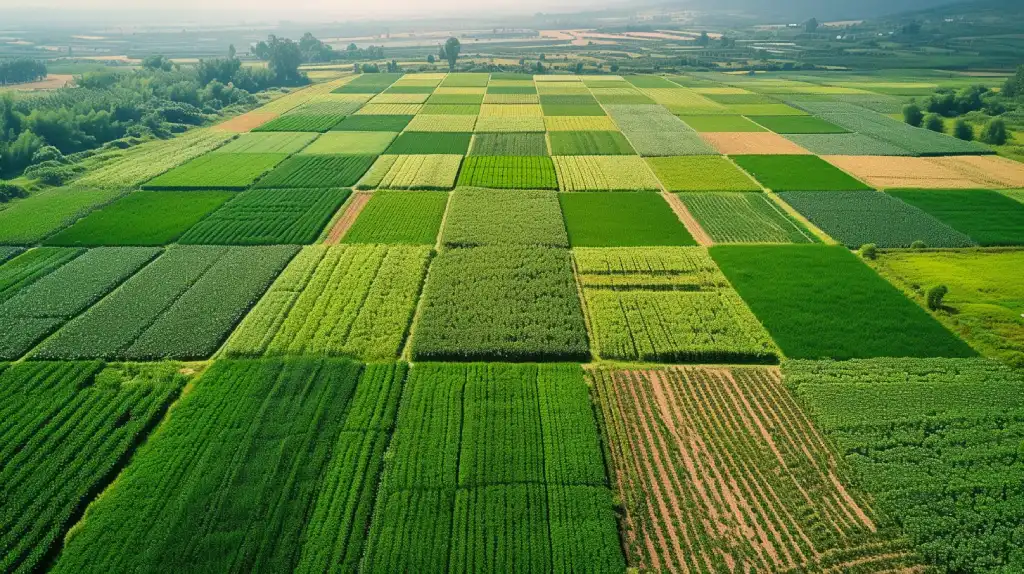Agricultural density measures the amount of arable land being actively farmed and helps calculate land usage efficiency.
It can improve agricultural efficiency and productivity. It provides ideas into how well resources are being used in a given area.
For example, Bangladesh has a high agricultural density with most of its land focused to farming due to its population pressure.
Alternatively, Australia has a low agricultural density with huge lands but fewer people interested in intensive farming.
The Netherlands dominates with one of the highest agricultural densities globally, increasing crop yield on limited land through advanced farming methods.
Agricultural Density
What is Agricultural Density?
Agricultural density is defined as the number of farmers per unit area of arable land.
Agricultural density = (Total number of farmers) / (Total area of farmland). This metric determines the average land size cultivated by each farmer.
It serves as an indicator of how heavily the farmland is populated with agricultural workers.
This measure helps in learning the relationship between farming practices and land availability, providing ideas into the potential for agricultural productivity and efficiency.
Importance of knowing Agricultural Density
Knowing agricultural density is vital for both farmers and policymakers. It helps in making informed decisions regarding land use, resource allocation, and sustainable farming practices.
By examining agricultural density, stakeholders can improve farming practices to increase productivity and confirm the sustainable use of land and other agricultural resources.
Illustrative Examples
For example, in a region where there are 100 farmers working on 1000 acres of farmland, the agricultural density would be 0.1 farmers per acre.
However, a highly urbanized area with limited farmland but a big number of small-scale farmers might have a much higher agricultural density, showing more intensive land use.
Comparison with related terms (Population Density)
While population density measures the number of people per unit area of land, agricultural density specifically focuses on the number of farmers per unit area of arable land.
This difference is important as it shows the use of land for farming purposes, rather than just the distribution of people across a given area.
Why Agricultural Density Matters

Impact on Agricultural Productivity
Agricultural density greatly affects productivity as it impacts how land and resources are managed.
High agricultural density often leads to more intensive farming practices, which can increase crop yields.
However, if not managed properly, it can also lead to overuse of land and resources, possibly damaging the soil and reducing long-term productivity.
Role in Land Management and Planning
Learning agricultural density is essential for effective land management and planning.
It helps in deciding how to distribute land for different agricultural activities, making sure that resources are used efficiently.
By studying agricultural density, planners can make informed decisions about where to focus development efforts and how to support sustainable agricultural practices.
Determining Agricultural Density
Methods and Calculations
Agricultural density is calculated by dividing the number of farmers by the total area of arable land. This calculation provides a ratio that helps in knowing how densely the farmland is being used.
Accurate measurement involves collecting data on both the number of active farmers and the amount of land available for agriculture.
Tools and Technologies Used
Modern tools and technologies such as Geographic Information Systems (GIS), satellite imagery, and remote sensing are employed to determine agricultural density.
These tools provide exact data on land use and help in monitoring changes over time. They are important for accurate measurement and analysis, allowing better planning and resource management in agriculture.
Benefits of Understanding Agricultural Density

Boosting Crop Management
Knowing agricultural density helps in planning crop management strategies effectively.
By understanding how densely the land is farmed, farmers can decide on crop rotation, planting schedules, and other practices that can improve yield and maintain soil health.
This knowledge is crucial for improving the use of available land and resources.
Improving Resource Usage
Agricultural density provides ideas into how resources like water, fertilizers, and labor are being used.
By examining this data, farmers can make better decisions on resource allocation, reducing waste and improving efficiency.
This leads to more sustainable farming practices, making sure that resources are used in a way that supports long-term agricultural productivity.
Importance of Agricultural Density
Impact on Crop Yield
Agricultural density directly affects crop yield as it determines how intensively the land is used. High agricultural density can lead to higher crop yields if managed properly, as it often involves more intensive farming practices.
However, it is important to balance this intensity with sustainable practices to avoid reducing the soil and reducing future yields.
Effect on Land Use and Resource Allocation
Agricultural density is essential in land use planning and resource allocation.
By knowing the density, planners and policymakers can make informed decisions about how to distribute land and resources to increase agricultural productivity.
This helps in assuring that agricultural practices are sustainable and that land is used efficiently.
Challenges and Considerations
Factors Affecting Accuracy
Various factors can affect the accuracy of agricultural density measurements, including difference in soil quality, climate conditions, and changes in land use patterns.
These factors can lead to changes in the number of active farmers and the amount of farmland, impacting the reliability of agricultural density data.
Potential Risks
High agricultural density can lead to several challenges, including soil loss, overuse of resources, and environmental degradation.
Intensive farming practices associated with high density can stress the land and lead to reduced long-term productivity.
It is essential to handle these potential risks by carrying out sustainable farming practices and monitoring land use carefully.
Applications in Modern Agriculture

Use in Planning and Development
Agricultural density data is vital for planning and development in the agricultural sector. It helps in identifying areas that require more intensive farming or areas that need conservation efforts.
By examining agricultural density, planners can develop strategies that support balanced and sustainable agricultural development.
Role in Sustainable Farming
Understanding agricultural density is crucial for promoting sustainable farming practices.
It helps in making sure that farming activities do not exceed the land’s capacity, preventing soil degradation and resource reduction.
Sustainable farming practices supported by agricultural density data contribute to long-term agricultural productivity and environmental health.
The Bottom Line
Agricultural density refers to the ratio of farmers to the amount of arable land they work on. This measure helps in estimating how deeply the land is being used for agriculture.
By studying agricultural density, farmers and planners can develop strategies that support sustainable agriculture and boost productivity. It provides ideas into how well resources are being used in a given area.
The future of agricultural density analysis looks hopeful with advancements in technology and data collection methods.
These improvements will improve our ability to monitor and manage agricultural density more accurately, supporting better decision-making in agriculture.
Continued focus on sustainable practices will make sure that agricultural density remains a valuable tool in promoting long-term agricultural success.




